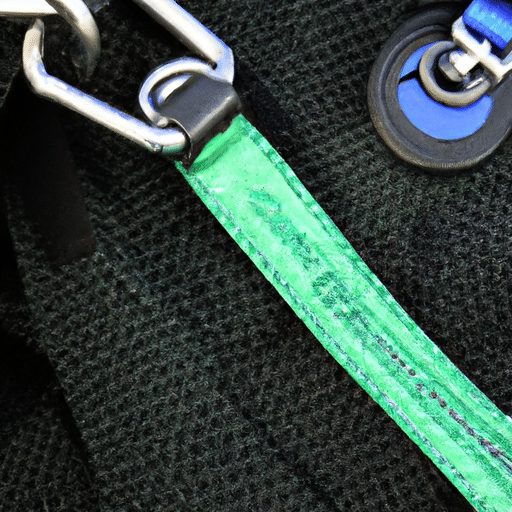Today, we are here to shed some light on a familiar yet often misunderstood topic – service dog harnesses. As we explore the world of these exceptional canines, we will uncover the distinctive qualities that set a service dog harness apart from its regular counterparts. Join us as we embark on a journey to uncover the hidden wonders of these specialized harnesses and gain a deeper understanding of their crucial role in enhancing the lives of individuals in need.
Definition of a Service Dog Harness
A service dog harness is a specialized vest or harness designed to assist individuals with disabilities in their day-to-day activities. These harnesses are carefully crafted and customized to meet the specific needs of service dogs and their handlers. Unlike regular harnesses, service dog harnesses are specially designed to provide support, comfort, and safety for both the dog and the handler.
Table of Contents
Function and Purpose
The primary function of a service dog harness is to act as a vital tool for service dogs and their handlers. These harnesses serve various functions, depending on the specific needs of the individual with a disability. They provide stability, balance, and support during mobility tasks, such as wheelchair assistance or walking aids. Additionally, service dog harnesses can also be equipped with additional features, such as handle or attachment points, which allow for better control and assistance for the handler.
Legal Requirements
In the United States, service dog harnesses are not explicitly required by law. However, the Americans with Disabilities Act (ADA) defines a service dog as a dog that is individually trained to perform tasks or assist individuals with disabilities. The law states that a service dog must be harnessed, leashed, or tethered, unless doing so would interfere with the dog’s ability to perform its tasks. Therefore, while not legally required, a service dog harness is often used as a tool to indicate that a dog is a working service dog.
Training and Certification
To become a service dog, extensive training and certification are necessary. Service dogs undergo specialized training to perform specific tasks that mitigate the effects of disabilities. Handlers also receive training on how to work effectively with their service dogs. While no certification is required by law in the United States, many individuals opt to have their service dogs certified by reputable organizations. These certifications provide validation of the dog’s training and often come with identification cards or patches that can be attached to the service dog harness.
Types of Service Dog Harnesses
Service dog harnesses come in a variety of types, each specifically designed to meet the needs of different disabilities or tasks. Here are some common types:
Mobility Support Harness
Designed for individuals with limited mobility or those who use mobility aids such as wheelchairs or walkers, mobility support harnesses provide stability, balance, and support. These harnesses are often equipped with handlebars that allow the handler to hold onto the dog for added assistance and guidance.
Guide Dog Harness
Guide dog harnesses are specifically designed for individuals with visual impairments or blindness. These harnesses are equipped with a handle that the handler can use to guide the dog. The handle provides a means of communication and helps the handler navigate obstacles and navigate through crowded areas.
Hearing Dog Harness
Hearing dog harnesses are designed for individuals who are deaf or hard of hearing. These harnesses are often equipped with a mechanism that allows the dog to alert the handler to sounds such as doorbells, alarms, or a baby crying. The hearing dog can then lead the handler to the source of the sound.
Medical Alert Dog Harness
Medical alert dog harnesses are designed for individuals with medical conditions such as diabetes, epilepsy, or allergies. These harnesses are often equipped with pockets or compartments where the dog can carry medical supplies or alert devices. The dog is trained to detect changes in the handler’s condition and provide assistance or alert others if needed.
Autism Support Dog Harness
Autism support dog harnesses are designed to provide emotional support and assistance for individuals with autism. These harnesses are often equipped with a handle that the individual can hold onto for comfort and stability. The dogs are trained to provide calming and grounding techniques to help alleviate stress or anxiety.
Psychiatric Service Dog Harness
Psychiatric service dog harnesses are designed to assist individuals with psychiatric disabilities such as post-traumatic stress disorder (PTSD) or anxiety disorders. These harnesses often have extra padding and support to provide a comforting and secure feeling for the handler. The dogs are trained to provide emotional support, interrupt anxiety or panic attacks, and create a calming presence.
Seizure Alert Dog Harness
Seizure alert dog harnesses are designed to assist individuals with seizure disorders. These harnesses are equipped with special handles or straps that can help guide or stabilize the handler during or after a seizure. The dogs are trained to alert family members or medical professionals of an impending seizure and provide assistance during or after the seizure event.
Diabetic Alert Dog Harness
Diabetic alert dog harnesses are designed for individuals with diabetes. These harnesses are often equipped with pockets or compartments where the dog can carry medical supplies or alert devices. The dogs are trained to detect changes in blood sugar levels and provide alerts or assistance when necessary.
Features of a Service Dog Harness
Service dog harnesses come with a range of features designed to enhance comfort, safety, and functionality for both the dog and the handler. Here are some key features to look for:
Durable and Sturdy Construction
Service dog harnesses should be made from high-quality materials that can withstand the wear and tear of everyday use. The harness should be durable, sturdy, and able to withstand pulling or tugging without compromising its integrity.
Adjustable Straps and Buckles
To ensure a proper fit, service dog harnesses should have adjustable straps and buckles. This allows for the harness to be properly secured to the dog’s body, preventing any discomfort or slipping.
Comfortable Padding and Lining
Comfort is of utmost importance for both the dog and the handler. Look for a service dog harness that is lined with comfortable padding to prevent chafing or rubbing. The padding should be breathable and moisture-wicking to prevent the dog from overheating.
Reflective Materials for Visibility
To ensure the safety of the handler and the dog, consider a service dog harness that has reflective materials or trim. This will increase visibility in low-light conditions, making it easier for others to see the dog and the handler.
Weight Distribution and Balance
A well-designed service dog harness will distribute the weight evenly, preventing any strain on the dog’s neck or back. Look for a harness that places the weight on the dog’s shoulders and chest, allowing for maximum comfort and mobility.
Handle or Attachment Points
Depending on the specific needs of the handler, a service dog harness may include a handle or attachment points. Handles provide a means of control and assistance, while attachment points can be used to secure additional equipment or devices.
Identification Patches and Pockets
Identification patches or pockets on the service dog harness allow the handler to display relevant information, such as the dog’s status as a service dog or specific medical conditions. This helps to easily identify the dog as a working service dog and provides crucial information to others.
Assistance Device Compatibility
Service dog harnesses may need to accommodate additional assistance devices such as backpacks, harnesses, or equipment. Look for a harness that has compatibility features, such as attachment loops or D-rings, to ensure easy integration with other necessary items.
Benefits of Using a Service Dog Harness
Using a service dog harness provides numerous benefits for both the handler and the dog. Here are some key advantages:
Enhanced Control and Safety
A service dog harness allows the handler to have better control over the dog, providing a safe and secure means of communication and guidance. The harness prevents the dog from pulling or lunging, ensuring the handler’s safety in various environments.
Efficient Distribution of Weight
Service dog harnesses are designed to distribute weight efficiently, preventing strain or injury to the dog’s neck or back. The even distribution of weight allows the dog to perform tasks comfortably, enhancing their overall performance and longevity.
Decreased Strain and Discomfort
The padding and lining of a service dog harness provide a comfortable and secure fit, reducing any potential discomfort or rubbing. This is particularly important for dogs that are required to wear the harness for extended periods.
Improved Communication and Focus
The use of a service dog harness helps facilitate better communication between the handler and the dog. The presence of the harness serves as a cue for the dog to remain focused on their tasks, providing clear signals and instructions from the handler.
Easy Identification and Awareness
Service dog harnesses often include identification patches or pockets that clearly indicate the dog’s working status and any relevant medical conditions. This helps to raise awareness and educate the public about the role of service dogs and their specific responsibilities.
Increased Independence and Mobility
For individuals with disabilities, a service dog harness significantly improves their independence and mobility. The harness allows them to navigate through various environments with confidence, overcoming physical barriers and accomplishing daily tasks more easily and safely.
Differences Between Service Dog Harnesses and Regular Harnesses
While regular harnesses may seem similar to service dog harnesses at first glance, there are several key differences between the two. These differences include:
Specific Training and Certification
Service dog harnesses are used exclusively for working dogs that have been specially trained to perform tasks for individuals with disabilities. Regular harnesses, on the other hand, are designed for use with any dog and do not require specialized training or certification.
Purpose and Functionality
Regular harnesses are primarily used for controlling and restraining dogs during walks or training sessions. Service dog harnesses have a specific purpose and functionality tailored to assist individuals with disabilities in various tasks, such as mobility support or medical alerting.
Design and Construction
Service dog harnesses are designed with specific features and materials to meet the unique needs of service dogs and handlers. Regular harnesses, although available in various designs and constructions, are not typically customized to provide the necessary support, comfort, or functionality of a service dog harness.
Reflective and Identification Features
Service dog harnesses often incorporate reflective materials and identification patches or pockets to enhance visibility and aid in identifying the dog’s working status. Regular harnesses may not have these features, as they are not intended to signify that the dog is a service dog.
Specialized Attachment Points
Service dog harnesses may have additional attachment points or loops to accommodate specialized devices or equipment. Regular harnesses typically lack these specialized attachment points since they do not require compatibility with additional assistance devices.
Legal Protections and Access Rights
Service dog harnesses, when properly used by individuals with disabilities, are protected by laws and regulations that grant them specific access rights. Regular harnesses do not provide any legal protections or access rights under disability rights laws.
Considerations When Choosing a Service Dog Harness
When selecting a service dog harness, there are several important considerations to keep in mind. These considerations ensure that the harness meets the needs of both the dog and the handler. Here are some factors to consider:
Dog’s Specific Needs and Abilities
Consider the specific tasks and requirements of the dog’s training. Dogs in different service roles may require different types of harnesses to support their tasks adequately.
Size, Fit, and Adjustability
Proper fit is crucial for the comfort and effectiveness of a service dog harness. Ensure that the harness is available in sizes that accommodate the dog’s measurements and that it is adjustable to provide a secure and comfortable fit.
Comfort and Durability
Look for a harness made from durable materials that can withstand rigorous use. Additionally, the harness should be comfortable for the dog to wear for extended periods without causing chafing or discomfort.
Training and Handling Techniques
Consider the training and handling techniques used with the dog. The harness should be compatible with the training methods employed and allow for proper communication and control during tasks.
Legal Requirements and Local Regulations
Familiarize yourself with the legal requirements and local regulations regarding service dog harnesses in your area. Ensure that the harness you choose complies with any specific guidelines or requirements.
Cost and Budget
Service dog harnesses can vary significantly in price, depending on the brand, features, and customization options. Consider your budget and balance it with your need for durability, functionality, and comfort.
Training and Proper Usage of Service Dog Harnesses
Proper training and usage of a service dog harness are essential for both the dog and the handler. Here are some key steps to follow:
Introduction to the Harness
Introduce the service dog harness to the dog gradually. Allow them to sniff and investigate the harness to become familiar with it before putting it on.
Getting Familiar with the Harness
Gradually increase the dog’s exposure to the harness, encouraging them to wear it for short periods. Reward the dog with treats and praise to create positive associations with the harness.
Adjusting and Securing the Harness
Ensure that the harness is adjusted properly to provide a secure and comfortable fit. Check that the straps are snug but not too tight, and make any necessary adjustments to ensure a proper fit.
Gradual Training and Positive Reinforcement
Introduce the dog to the concept of wearing the harness during training sessions. Gradually increase the duration the dog wears the harness while providing positive reinforcement such as treats or playtime.
Consistent Use and Maintenance
Consistently use the service dog harness during working hours. Additionally, regularly inspect the harness for any signs of wear or damage and replace it if necessary. Clean the harness according to the manufacturer’s recommendations to maintain its condition.
Monitoring and Reevaluating Fit
Regularly monitor the fit of the service dog harness, especially as the dog grows or ages. Make adjustments as needed to ensure a secure and comfortable fit for the dog’s changing body.
Common Misconceptions about Service Dog Harnesses
There are several common misconceptions about service dog harnesses that are important to address:
Service Dogs vs. Emotional Support Animals
Service dogs undergo rigorous training to perform specific tasks for individuals with disabilities. In contrast, emotional support animals, while providing comfort and emotional well-being for their owners, do not possess the same level of training and task-specific abilities as service dogs. Therefore, a service dog harness is not appropriate or necessary for an emotional support animal.
Invisibility of Disabilities
Not all disabilities are visible to the public eye. Service dog harnesses act as visual cues that signify the dog’s working status and the handler’s need for assistance. These harnesses help raise awareness about invisible disabilities and educate the public about the appropriate behavior around service dogs.
Public Access Rights
Service dog harnesses are a tool that allows individuals with disabilities and their service dogs to access public spaces. However, it is important to note that public access rights are legally protected for service dogs, regardless of whether they are wearing a harness. The harness simply serves as a visual indicator that the dog is a working service dog.
Necessity of Vests or Harnesses
Service dogs are not legally required to wear vests or harnesses. However, the ADA does stipulate that the dog must be harnessed, leashed, or tethered, unless doing so would interfere with the dog’s ability to perform its tasks. Therefore, while not mandated by law, a service dog harness is often used as a practical and visible means of adhering to this requirement.
Uniform Styles and Color Requirements
There are no specific uniform styles or color requirements for service dog harnesses. As long as the harness meets the necessary functionality and legal requirements, handlers have the flexibility to choose a style, color, or design that suits their preferences or needs.
Legal Considerations and Guidelines
When using a service dog harness, it is important to be aware of the legal considerations and guidelines that apply. Here are a few key points to keep in mind:
Americans with Disabilities Act (ADA)
Under the ADA, individuals with disabilities have the right to be accompanied by their service dogs in most public places. This includes restaurants, stores, and other businesses open to the public. Service dog harnesses help identify and inform others about the dog’s working status, reinforcing the rights of individuals with disabilities.
Rights and Responsibilities
Service dog handlers have rights, but they also have responsibilities. It is crucial to understand and respect the rights of business owners and the general public. Properly using and maintaining a service dog harness can help foster positive interactions and cooperation between handlers and others.
Fraud and Misrepresentation
Fraudulently misrepresenting a pet as a service dog is not only unethical but also illegal in many jurisdictions. Misrepresenting a pet as a service dog undermines the rights of individuals with disabilities and can lead to unnecessary regulations or restrictions. Using a service dog harness responsibly helps maintain the integrity of the service dog community.
Airline Travel Regulations
While service dogs are generally allowed on airplanes, airlines may have specific regulations and requirements regarding service dog harnesses. It is essential to familiarize yourself with the specific airline’s policies to ensure compliance and a smooth travel experience.
State and Local Laws
In addition to federal laws, state and local laws may also have specific guidelines and requirements for service dog harnesses. Research and understand the laws in your specific area to ensure compliance and a positive experience for both the handler and the dog.
Conclusion
Service dog harnesses are incredibly valuable tools that assist individuals with disabilities in their day-to-day lives. These specialized harnesses provide support and safety for both the dog and the handler, while also acting as a visual indicator of the dog’s working status. From mobility support to medical alerting, service dog harnesses are designed to meet a wide range of needs and tasks. By understanding the different types of harnesses, their features, and the legal considerations, individuals can make informed decisions when selecting a service dog harness. Proper training, usage, and maintenance of these harnesses ensure the comfort, safety, and effectiveness of service dogs in their essential roles.






























